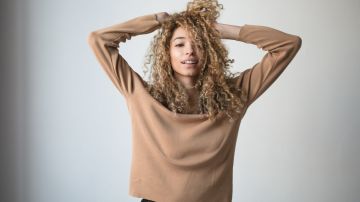Why We Need To Stop Associating High Maintenance Hair With “Bad Hair”
Last year the Internet sighed a collective “aww” of sympathy when 5-year-old Ryleigh Lynne attempted to create her own YouTube video tutorial for styling natural hair

Photo: Unsplash/@thoughtcatalog
Last year the Internet sighed a collective “aww” of sympathy when 5-year-old Ryleigh Lynne attempted to create her own YouTube video tutorial for styling natural hair. As with most natural hair journeys, the video started off positively, with Ryleigh setting out all her necessary potions, lotions, and materials to style her beautiful mane. Yet, within the span of less than four minutes things quickly went south, with Ryleigh spilling water from her spray bottle onto her face and eventually exclaiming (in the cutest and most relatable way) “Man. It’s too much hair.” In true hero form, she eventually “lays her edges” and leaves the rest to fly free—a resignation and victory all at once. Not only was the video cute, but it was one of the most real reflections of the #naturalhairstruggle we’ve seen online—a tutorial and cautionary tale all at once.
Ryleigh’s experience is one many women of color who have pursued a natural hair journey can call their own. Since the natural hair movement exploded, relaxer sales have decreased by 36% from 2012 to 2017 and natural hair product sales have gone through the roof with women purchasing various shampoos, conditioners, styling creams, gels, and mousses to maintain their crowns. Yet, one refrain that has been whispered (and sometimes screamed in frustration) is that it’s just too much work.
Washing my hair today! Yes I typed it like it's an event cos it will literally have a start, middle & end & take HOURS! #NaturalHairStruggle
— Amina (@_thisisamina) February 26, 2017
The hashtag #naturalhairstruggle has more than 11,000 uses on Instagram alone with women sharing their experience of having to spend hours maintaining or creating various natural hair looks. And for some natural hair girls, this has led to unwarranted suggestions that their “high maintenance” hair is unmanageable and not as good as lower maintenance hair (i.e. hair textures that are less curly, soft and wavy, or straight).
“I have true 4c hair, so I don’t have a defined curl pattern,” said beauty influencer, Clare Brown Meneely tells HipLatina. “I still think ‘unmanageable’ is the wrong word to describe my highly textured hair. I think a better word is unexpected. When I style my hair I never know exactly what I am going to get. Products don’t work on my hair the same way they may work on a girl with looser and more defined curls. However, I manage it just fine—it’s healthy and growing.”
Sherly Tavarez, fashion stylist, founder of Hause of Curls and creator of the Pelo Malo Where? t-shirt line, believes that hair that requires a bit more TLC is not necessarily something to call “bad hair.”
“It is not as simple to manage [curly or kinky hair] as [opposed to] straight hair simply because we don’t just wake up and go, we have to put effort into it,” she says. “Whether it’s the wash-and-go process or refreshing our curls, we are constantly trying to keep our mane moisturized and happy. Natural hair requires just a bit more love and attention … “
She also points out that natural hair is often considered beautiful and “trendy,” which calls into question just how “bad” higher-maintenance hair can be. Perhaps, instead, natural girls should believe that the time and energy they put into their hair is precisely what makes it beautiful and coveted after all. Or, as Clare suggests, women should begin embracing all types of hair as beautiful, regardless of the care and maintenance process it requires.
“I don’t think the time it takes to style natural hair makes natural hair culturally less appealing,” said Clare. “Natural hair is a lifestyle choice. It does take more time than straight styles. But, I don’t think there is anything wrong with choosing to wear your hair straight because it is easier [either].”
So how do naturally curly girls maintain all of their luscious curls?
Lead stylist at Cole Stevens Salon in Washington, D.C., Ashlee Durante Stevens, suggests that women who choose to wear their hair curly purchase Design Essentials Naturals Almond and Avocado line.
“The cream and foam are so good for natural curls,” the stylist suggests. As for Clare, she makes an important point for girls looking to style more tightly curled textures.
“It is important to embrace the hair you have. Unfortunately, the natural hair movement puts ringlet curls on a pedestal. This can feel isolating for women who have a coily texture. So find hair influencers with your hair type and use them as inspiration,” she adds. “Also, don’t cover your hair so much. Protective style can be great— but if you only wear your hair in a protective style you will never learn how to care for it.”
Sherly also recommends that women with natural hair practice patience when they first dive into styling. “It won’t happen overnight but MANY girls will testify to it happening if you really want it! Learn about your hair and how to care for it and that’s pretty much it,” she says.
Women looking to test products can also consider signing-up for CURLBOX, a monthly subscription box that allows curly girls to test various brands’ sample-sized products and discover the right product for their hair.
Just remember that at the end of the day there is NOT such thing as bad hair.

















